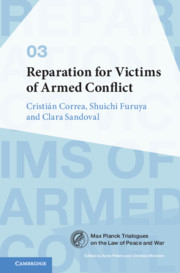Book contents
- Reparation for Victims of Armed Conflict
- Max Planck Trialogues on the Law of Peace and War
- Reparation for Victims of Armed Conflict
- Copyright page
- Contents
- Introduction
- 1 The Right to Reparation for Victims of Armed Conflict
- 2 Operationalising the Right of Victims of War to Reparation
- 3 International Human Rights Adjudication, Subsidiarity, and Reparation for Victims of Armed Conflict
- Conclusion
- Index
- Books in the Series
1 - The Right to Reparation for Victims of Armed Conflict
The Intertwined Development of Substantive and Procedural Aspects
Published online by Cambridge University Press: 03 December 2020
- Reparation for Victims of Armed Conflict
- Max Planck Trialogues on the Law of Peace and War
- Reparation for Victims of Armed Conflict
- Copyright page
- Contents
- Introduction
- 1 The Right to Reparation for Victims of Armed Conflict
- 2 Operationalising the Right of Victims of War to Reparation
- 3 International Human Rights Adjudication, Subsidiarity, and Reparation for Victims of Armed Conflict
- Conclusion
- Index
- Books in the Series
Summary
The shift to a more victim-oriented understanding of the right to reparation has been developing in tandem with the successive creation of international criminal judiciaries, as well as ad hoc reparation mechanisms, established since the early 1990s, in parallel with the drafting of relevant UN instruments. However, the abstract question about the existence of such a right is not particularly helpful because the individual substantive right and procedural right are closely intertwined. The concrete content of the right to reparation has to be defined under specific historical circumstances, taking into account the specific challenges of concrete post-conflict constellations. The substance of a right to reparation only can and should be defined as the result of an adequate procedure established under such circumstances. Accordingly, this chapter, based on the analyses of various reparation mechanisms so far established, contributes to identify and elaborate the detailed elements of the right to reparation, including the basic shared principles and methods through which a mechanism could effectively process individual claims. This also clarifies the shifting purpose of reparation not only to deliver remedial justice to victims, but also to realise restorative justice which emphasises reconciliation in States and local communities at the post-conflict stage.
Keywords
- Type
- Chapter
- Information
- Reparation for Victims of Armed Conflict , pp. 16 - 91Publisher: Cambridge University PressPrint publication year: 2020
- 1
- Cited by



